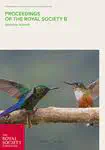The evolution of sexually dimorphic traits in ecological gradients: an interplay between natural and sexual selection in hummingbirds

Abstract
Traits that exhibit differences between the sexes have been of special interest in the study of phenotypic evolution. Classic hypotheses explain sexually dimorphic traits via intra-sexual competition and mate selection, yet natural selection may also act differentially on the sexes to produce dimorphism. Natural selection can act either through physiological and ecological constraints on one of the sexes, or by modulating the strength of sexual/social selection. This predicts an association between the degree of dimorphism and variation in ecological environments. Here, we characterize the variation in hummingbird dimorphism across ecological gradients using rich databases of morphology, colouration and song. We show that morphological dimorphism decreases with elevation in the understorey and increases with elevation in mixed habitats, that dichromatism increases at high altitudes in open and mixed habitats, and that song is less complex in mixed habitats. Our results are consistent with flight constraints, lower predation pressure at high elevations and with habitat effects on song transmission. We also show that dichromatism and song complexity are positively associated, while tail dimorphism and song complexity are negatively associated. Our results suggest that key ecological factors shape sexually dimorphic traits, and that different communication modalities do not always evolve in tandem.